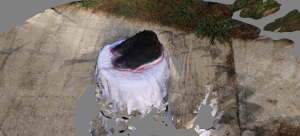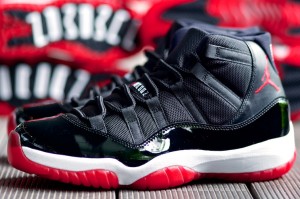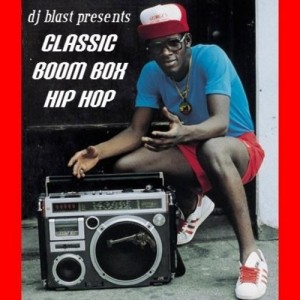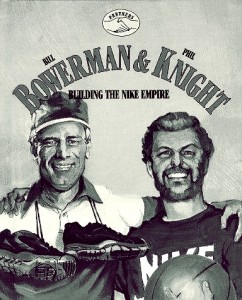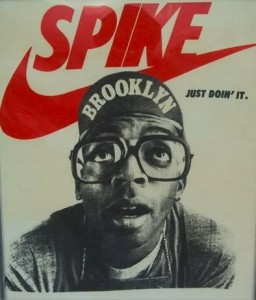The bottom of the artifact is quite unique, compared to other objects of its kind. The bottom measures to thirteen inches long, and its outline resembles that its owner is relatively large. The bottom is made of a red-see through rubber material, while the red material forms the shape of a foot. The portion of rubber, where one would imagine the heel of the foot contains a separate black portion of rubber, which is shaped like a boomerang. Six inches above the boomerang shaped section is another section of black rubber, which is shaped like the pokemon Ditto. The inside of both black portions of rubber contains ridges that are a lot closer together than the red ridges surrounding them. While the surrounding ridges are separated by approximately half of an inch, the black rubber inside of the red ridges is less than one centimeter apart from one another. While the red ridges are wavy in shape, the black ridges are of a zigzag nature. If one were to run their finger down this particular rubber portion, aside from the occasional pieces of dirt one’s finger would encounter, one will feel a gritty rubber with the jagged touch of what could only be rocks stuck between the ridges.
The object that serves as the subject of my analysis measures to a total of thirteen inches long and six inches high. The sole is divided into two parts, which the designers have said create a more flexible feel for the user of the object. Horizontal ridges begin at the toe of the shoe and transition around the entire artifact. The upper portion of the sole is an inch-and-a-half of white cushioning that when contrasted with the lower red portion and other materials of the artifact, make the artifact much more noticeable.
Looking downward on the object, the light reflects rather brightly above what seems to be a white foundation. The section of the shoe that covers what one can assume would rest a set of toes sits on a double-layered sole, and is made of black patent leather, which resembles the dress shoes of an army command sergeant major. Above the patent leather portion of the sneaker is a material with more texture than the black patent leather and possess six vertical slits on each side in order to hold the laces of the artifact. The black patent leather on top of the double-layered sole creates a red, black, and white combination that coordinates rather nicely with the Chicago Bulls of the National Basketball Association game jerseys.
The crisscross nature of small threads continues upward, only to end in a slightly larger bow. The small threads rest on the tongue of the object and in between one of the threads half way up rest letters that resemble the ancient Greek letters. On the tongue of the artifact, there is writing that if you look at from the perspective of a front view resembles Greek lettering, but if you turn it sideways reads, “Jumpman Jordan.” In between the words “Jumpman” and “Jordan” is the iconic Jordan symbol, which is also on the back of the sneaker.
The Jumpman Jordan symbol, which is also the logo for the entire brand that surrounds that artifact, is a silhouette of the famous basketball player Michael Jordan. The symbol reflects what seems to be Jordan flying through the air palming a basketball over his head with his right hand in what appears to be an attempt to slam-dunk the basketball. His left hand is lowered behind his body with all five of Jordan’s fingers extended near his thigh. His legs are spread as if Jordan is attempting to do a split in the air. His left foot is pointed in forward, which one can only guess is the location of the basketball rim Jordan is attempting to slam the basketball in, and his right foot is pointing outward making Jordan’s posture a position only a well trained athlete could accomplish. The symbol sits perfectly on the back of the Air Jordan Retro 11!
Music and sports have always proven to be areas in which African Americans found themselves able to advance past the societal stereo-types of America. During the 1980’s, hip-hop served as the voice of the African-American community. The lyrical messages of hip-hop along with street fashion combined to form a sound and aesthetic that many African Americans in urban communities came to identify with. The black youth of the 1980’s used hip-hop as a channel to articulate their feelings of isolation from the popular culture of the United States. Thus, the spirit of the hip-hop developed as an expression of the hardships of black urban life.
Sneakers were an intricate part of urban culture in the 80’s. Early hip-hop artist used various sneaker brands to express their affiliations and status. The rap group Run-DMC hit song, “My Addidas,” landed the group a one million dollar deals with Addidas, a conservative German company. The French director Mathieu is quoted as saying that “ Run-DMC really made the world understand that the sneaker is to hip-hop what the crucifix is to Christians.” Other notable rappers adopted their own brands to express their own identities: Fresh Gordan’s “My Filas”; Heavy D and Nike; Busy Bee and Converse; and the Beastie Boys and Suede Addidas. However, with the emergence of a new African American basketball superstar, hip-hop culture would be introduced to a new brand that would give hip-hop a new face for years to come.
Michael Jordan was born February 17, 1963, in Brooklyn, New York. After moving to North Carolina and playing high school basketball, Jordan signed with The University of North Carolina at Chapel Hill on a basketball scholarship. During his junior season, which would prove to be his last as a collegiate athlete, Jordan led the North Carolina Tar Heels to a N.C.A.A championship. In the same year, Jordan would also help Team U.S.A win a gold-medal in the 1984 Olympic games.
Jordan decided to leave college a year early and enter the N.B.A draft. He was selected third overall by the Chicago Bulls. Jordan’s entrance into the N.B.A would allow him the ability to sign a shoe contract, and unknown to Jordan, change the shoe industry forever.
Today’s Nike Inc. was founded on January 25, 1964, as Blue Ribbon Sports by Bill Bowerman and Phil Knight. Blue Ribbon Sports would officially become Nike Inc. on May 30, 1971. Before Nike signed Jordan in 1984, Nike was mainly a running shoe company, who’s target audience reflected that of their white audience At the time, Nike had set forth to capitalize on the running boom of the 1970’s, yet by the mid 80’s, because of mismanagement and structural problems, Nike was approaching the verge of failure. In 1984, the year they would sign the rookie Michael Jordan, they recorded their first drop in earnings.
At the beginning of negotiations, neither Michael Jordan nor Nike Marketing Director Rob Strasser seemed the least bit excited about the partnership. Strasser felt that “unless it was possible to make one big marketing package—tie the brand, the product, the advertising, and the athlete into one personality—they should forget it.” Nike knew that signing Jordan would be a huge risk, because they realized that the success of their product would be tied exclusively to Jordan’s success as an N.B.A player.
Jordan sneaker of choice when playing basketball had always been Converse, and like many other young African American males of the 80’s, Jordan was also fond of Adidas. Jordan has been quoted as saying that he like many of his other contemporaries thought Adidas made the best product, and had he gotten a decent offer from either Converse or Adidas, he would have signed with them. Nike, which prided itself in taking chances, pledged to use its entire $500,000 dollar advertising budget on Jordan in addition to compensation for him also wearing the Nike shoes.
Jordan ended up signing with Nike for $2.5 million; however, because Nike realized that there success was tied in directly with Jordan’s success as a player, Nike inserted a clause into the contract, which stated that unless Jordan accomplished either Rookie of the Year honors, become an All-Star, or average 20 points per game, Nike had the right to terminate the contract. Needless to say, the contract was never severed. During Jordan’s Rookie season while wearing the Air Jordan 1, Jordan averaged 28.2 points per game, earned a spot on the All Star team, and on May 16, 1985, was named the 1985 N.B.A Rookie of the Year; thus, fulfilling his contractual obligations to Nike.
On October 18, 1984, the N.B.A officially banned the black and red Air Jordan 1’s, because the N.B.A claimed that they violated the uniform dress code policy. At the time, the N.B.A required its players to wear either primarily black or primarily white shoes. For violating this policy, Jordan was fined $5,000 a game, a tab that Nike was happy to pick up. A simple shoe violation wouldn’t be the only controversy Michael Jordan and Nike would be involved in.
Michael Jordan and Nike were redefining not only the shoe industry but also the way business is done in America in general. Never before had a company made an African American male the face of their corporation. A Newsweek article asserted that “The athletic-wear giant is one of a growing number of companies that have begun to use ads made not only with, but by, blacks. The reason isn’t hard to figure out: blacks have become a powerful consumer force. . . To reach them. . . marketers are striving for ads with an ‘authentic’ feel for black music, language, and lifestyles.”
To capture this authentic feel for black music, language, and lifestyles, Nike’s advertising agency, Wieden and Kennedy, hired Spike Lee in 1986 to direct commercials staring Michael Jordan. The agency’s copywriter is noted to have developed an idea to pair Jordan and Lee, because of a character in Lee’s film She’s Gotta Have It (1986). In the film, the character Mars Blackmon refused to take off his Air Jordan’s, even while making love, because they were so important to his sense of identity as a young black man. Spike Lee was one of the most popular African American film directors of his generation. Lee is known for creating films such as Do the Right Thing and Mo Better Blues, which depicted the African American point of view at a time that many in the black communities felt that such a depiction was non-existent in America. The relationship developed into a 16-year relationship, which resulted in the “Mars and Mike” campaign ads that featured Mars Blackmon.Lee’s film’s countered what he himself referred to as the exploitation of African Americans with a “powerful social commentary.” Lee’s 1989 film, Do the Right Thing has been referred to as “the standard bearer for Hollywood on race relations.”
The design of the Air Jordan Retro 11 was a subtle cry for attention from an athlete who was known for being relatively conservative. It stands to reason that the color scheme was designed to match that of the Chicago Bulls team colors. Whether or not the Bulls wore their white home jerseys, black with red striped away jerseys, or red alternate jersey Jordan could wear this sneaker if he felt the need. But the color scheme seems to be the only normal aspect of the shoe, relative to sneakers of its day.The patent leather used on the bottom portion of the sneaker is a clear call for attention. Patent leather was rarely used at the time of this particular Air Jordan’s release, and when it was, it was reserved exclusively for women’s shoes. The use of the shiny material was extremely risky for the shoes success, but clearly neither Nike nor Jordan cared. They seemed to be challenging the way sneakers were designed during that time.
Although, the shoe’s patent leather design made it quite noticeable, make no mistake, the shoe’s designer still had basketball in mind while designing the sneaker. The horizontal ridges in the rubber material at the bottom of the shoe allowed for maximum grip, which allowed Jordan to cut back and forth as he used his cross over dribble and raise off of the floor to implement his famous slam dunk. While the shoe’s sole is also extremely flexible to provide freedom of movement for Jordan’s foot, the sneaker still provided adequate ankle support for a professional basketball player. The sneaker, like most of its day, cam up to the middle of Jordan’s ankle, and was tied rather tightly to prevent, what one can deduce as a sprained ankle.
When this sneaker was released, Jordan was probably hesitant about the design, but gave the benefit of the doubt to Nike, because of previous success. By the time this sneaker released, Jordan was already a champion, all-star, and an overall success; therefore, the failure of such an eccentric shoe, relatively speaking, was far from his mind. If any other player, who had not been as established as Jordan, it stands to reason that this sneaker would not have done as well as it did. However, with that being said, the sneaker’s success is not due solely to Michael Jordan. The success of the Air Jordan Retro 11 is due to a synthesis of things: Michael Jordan’s success, Nike’s brilliant advertising, and hip hop culture.


